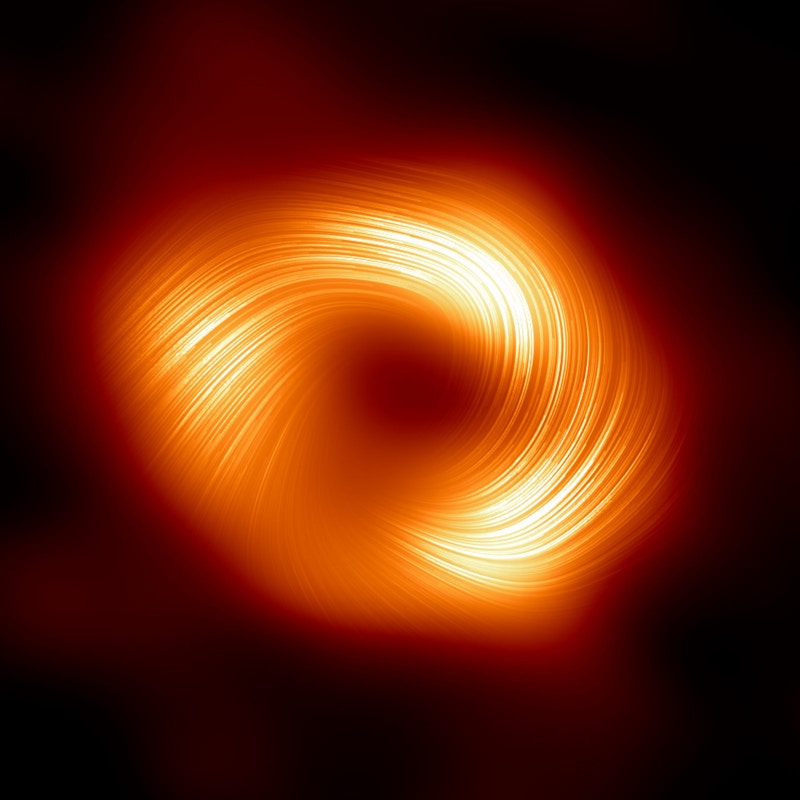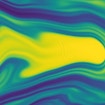Astronomers Unveil Strong Magnetic Fields Spiraling at the Edge of Milky Way’s Central Black Hole

A new image from the Event Horizon Telescope (EHT) collaboration has uncovered strong and organized magnetic fields spiraling from the edge of the supermassive black hole Sagittarius A* (Sgr A*). Seen in polarized light for the first time, this new view of the monster lurking at the heart of the Milky Way galaxy has revealed a magnetic field structure strikingly similar to that of the black hole at the center of the M87 galaxy, called M87*, suggesting that strong magnetic fields may be common to all black holes. This similarity also hints toward a hidden jet in Sgr A*. The results were published March 27 in two papers in The Astrophysical Journal Letters.
Scientists unveiled the first image of Sgr A* — which is approximately 27,000 light-years away from Earth — in 2022, revealing that despite the fact that the Milky Way’s supermassive black hole is less than a thousandth the size and mass of M87’s, they look remarkably similar.
This discovery caused scientists to wonder whether the two share any traits other than their appearance. To find out, the team decided to study Sgr A* in polarized light. Previous studies of light around M87* revealed that the magnetic fields around the black hole giant allowed it to launch powerful jets of material back into the surrounding environment. Building on this work, the new images have revealed that the same may be true for Sgr A*.
“What we’re seeing now is that there are strong, twisted and organized magnetic fields near the black hole at the center of the Milky Way galaxy,” says Sara Issaoun, NASA Hubble Fellowship Program Einstein Fellow at the Center for Astrophysics | Harvard & Smithsonian and co-lead of the project. “Along with Sgr A* having a strikingly similar polarization structure to that seen in the much larger and more powerful M87* black hole, we’ve learned that strong and ordered magnetic fields are critical to how black holes interact with the gas and matter around them.”

Light is an oscillating, or moving, electromagnetic wave that allows us to see objects. Sometimes light oscillates in a preferred orientation, and we call it polarized. Although polarized light surrounds us, to human eyes it is indistinguishable from nonpolarized light. In the plasma around these black holes, particles whirling around magnetic field lines impart a polarization pattern perpendicular to the field. This allows astronomers to see in increasingly vivid detail what’s happening in black hole regions and to map their magnetic field lines.
“By imaging polarized light from hot glowing gas near black holes, we are directly inferring the structure and strength of the magnetic fields that thread the flow of gas and matter that the black hole feeds on and ejects,” says Harvard Black Hole Initiative Fellow and project co-lead Angelo Ricarte. “Polarized light teaches us a lot more about the astrophysics, the properties of the gas and [the] mechanisms that take place as a black hole feeds.”
But imaging black holes in polarized light isn’t as easy as putting on a pair of polarized sunglasses, and this is particularly true of Sgr A*, which is changing so fast that it doesn’t sit still for pictures. Imaging the supermassive black hole requires sophisticated tools above and beyond those previously used for capturing M87*, a much steadier target. EHT Project Scientist Geoffrey Bower from the Institute of Astronomy and Astrophysics, Academia Sinica, Taiwan, says, “Making a polarized image is like opening the book after you have only seen the cover. Because Sgr A* moves around while we try to take its picture, it was difficult to construct even the unpolarized image.” Due to Sgr A*’s movement, he adds, the first image was in fact an average of multiple images. “We were relieved that polarized imaging was even possible,” Bower says. “Some models were far too scrambled and turbulent to construct a polarized image, but nature was not so cruel.”
With the image in hand, the next step was to use it to glean information about the black hole. Jordy Davelaar, a research fellow at the Flatiron Institute’s Center for Computational Astrophysics, generated over 1 million images of what the Sgr A* might look like using a computer program he co-developed called RAPTOR. Each image assumes a different set of properties for Sgr A*. By comparing the real image with RAPTOR’s mock-ups — and additional images generated by two similar projects — Davelaar and his colleagues learned new information about the black hole, including new constraints on its spin and magnetic fields.
Curiously, Davelaar says that the new information about Sgr A* deepens a mystery. A rotating black hole with such powerful and orderly magnetic fields should shoot off colossal beams of particles called jets at nearly light speed from its poles. “It’s almost a given,” Davelaar says. Yet clear direct evidence of a jet from Sgr A* is still missing.
Such jets have been seen coming from the black hole at the center of M87. Mariafelicia De Laurentis, EHT Deputy Project Scientist and professor at the University of Naples Federico II in Italy, says, “The fact that the magnetic field structure of M87* is so similar to that of Sgr A* is significant because it suggests that the physical processes that govern how a black hole feeds and launches a jet might be universal among supermassive black holes, despite differences in mass, size and surrounding environment. This result allows us to refine our theoretical models and simulations, improving our understanding of how matter is influenced near the event horizon of a black hole.”
Davelaar says Sgr A*’s jets may be aimed in such a way that we can’t easily spot them from Earth. Another explanation is that the jets are too meager for us to see, or that something in Sgr A*’s makeup prevents it from producing jets. “There might be something hidden there that we don’t understand yet that makes M87* a different ‘engine’ than Sgr A*,” Davelaar says. Future observations, in tandem with computer models, will help resolve the mystery, he says.
The EHT has conducted several observations since 2017 and is scheduled to observe Sgr A* again in April 2024. Each year, the images improve as the EHT incorporates new telescopes, larger bandwidth and new observing frequencies. Planned expansions for the next decade will enable high-fidelity movies of Sgr A*; may reveal a hidden jet; and could allow astronomers to observe similar polarization features in other black holes. Meanwhile, extending the EHT into space will provide sharper images of black holes than ever before.
More Information
This research was presented in two papers by the EHT collaboration published March 27 in The Astrophysical Journal Letters: “First Sagittarius A* Event Horizon Telescope Results. VII. Polarization of the Ring” and “First Sagittarius A* Event Horizon Telescope Results. VIII. Physical Interpretation of the Polarized Ring.”
The EHT collaboration involves more than 300 researchers from Africa, Asia, Europe, and North America and South America. The international collaboration is working to capture the most detailed black hole images ever obtained by creating a virtual Earth-size telescope. Supported by considerable international investment, the EHT links existing telescopes using novel systems — creating a fundamentally new instrument with the highest angular resolving power that has yet been achieved.
The individual telescopes involved in the EHT in April 2017, when the observations were conducted, were: the Atacama Large Millimeter/submillimeter Array (ALMA), the Atacama Pathfinder Experiment (APEX), the Institut de Radioastronomie Millimétrique (IRAM) 30-meter Telescope, the James Clerk Maxwell Telescope (JCMT), the Large Millimeter Telescope Alfonso Serrano (LMT), the Submillimeter Array (SMA), the UArizona ARO Submillimeter Telescope (SMT) and the South Pole Telescope (SPT). Since then, the EHT has added the Greenland Telescope (GLT), the IRAM Northern Extended Millimeter Array (NOEMA) and the UArizona ARO 12-meter Telescope on Kitt Peak to its network.
The EHT consortium consists of 13 stakeholder institutes: the Academia Sinica Institute of Astronomy and Astrophysics, the University of Arizona, the University of Chicago, the East Asian Observatory, Goethe-Universität Frankfurt, Institut de Radioastronomie Millimétrique, Large Millimeter Telescope, Max Planck Institute for Radio Astronomy, MIT Haystack Observatory, National Astronomical Observatory of Japan, Perimeter Institute for Theoretical Physics, Radboud Universiteit and the Smithsonian Astrophysical Observatory.
Information for Press
For more information, please contact [email protected].
- Link to scientific papers (first paper; second paper)
- Link to high-resolution Sgr A* image (TIFF version available upon request)
- Link to high-resolution comparison of Sgr A* and M87*
- Link to downloadable video
Additional Press Contacts
Sara Issaoun
Center for Astrophysics | Harvard & Smithsonian, USA
[email protected]
Angelo Ricarte
Center for Astrophysics | Harvard & Smithsonian, USA
[email protected]
Jordy Davelaar
Flatiron Institute
[email protected]
Mariafelicia De Laurentis
EHT Deputy Project Scientist
University of Naples Federico II, Italy
[email protected]


